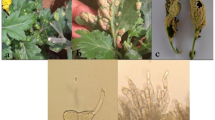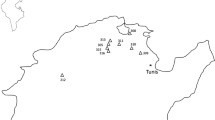Abstract
Sclerotium delphinii is a common pathogen that causes wilting in a number of plants. In recent years, the genus Sclerotium has been reported as one of those responsible for leaf spots in Piper nigrum in the Amazonian humid tropical regions. In 2017–2018, several black pepper plants presented symptoms of concentric leaf spots. Five isolates were obtained in this study for morphological and phylogenetic characterizations and pathogenicity test. Initially, the gene regions (ITS and LSU) were amplified and sequenced. Phylogenetic analysis confirmed the grouping of the five isolates with the S. delphinii reference isolate (CBS 672.71). The isolates produced sclerotia in all culture media, but some of them altered their capacity to produce sclerotia. The inoculated isolates induced irregular necrotic lesions in the pathogenicity assay using detached leaves. The symptomatic leaves were re-isolated and the fungus culture obtained. No fungus growth was observed in the leaves used as control. This study is the first record of S. delphinii causing leaf spots on P. nigrum in Brazil.





Similar content being viewed by others
References
Assis LAG, Neto RAC, Barbosa AP (2007) Ocorrência de mancha foliar em mogno causada por Sclerotium coffeicola no Estado do Amazonas. Summa Phytopathol 33:99
Duarte MLR, Albuquerque FC (2004) Cultivo da pimenta-do-reino na região norte / Maria de Lourdes Reis Duarte. - Belém: Embrapa Amazônia Oriental
Farr DF, Rosmman AY (2020) Fungal database, systematic mycology and microbiology LABORATORY, ARS, USDA. Available at: http://nt.ars-grin.gov/fungaldatabases/. Accessed on 12 Mar 2020
Hanlin RT, Tortolero O (1989) Morphology of Sclerotium coffeicola, a tropical foliar pathogen. Can J Botany 67:1852–1860
Harlton CE, Levesque CA, Punja ZK (1995) Genetic diversity in Sclerotium (Athelia) rolfsii and related species. Phytopathol 85:1269–1281
Hepperle D (2004) SeqAssem©: Win32-Version. a sequence analysis tool contig assembler and trace data visualization tool for molecular sequences. Available at: http://www.sequentix.de
Kumar S, Stecher G, Li M, Knyaz C, Tamura K (2018) MEGA X: Molecular evolutionary genetics analysis across computing platforms. Mol Biol Evol 35:1547–1549
Mahadevakumar S, Chandana C, Deepika YS, Sumashri KS, Yadav V, Janardhana GR (2018) Pathological studies on the Southern blight of China aster (Callistephus chinensis) caused by Sclerotium rolfsii. Eur J Plant Pathol 151:1081–1087
Mahadevakumar S, Janardhana GR (2016) Morphological and molecular characterization of southern leaf blight of Psychotria nervosa (wild coffee) incited by Sclerotium rolfsii. J Plant Pathol 98:351–354
Mendes MAS, da Silva VL, Dianese JC (1998) Fungos em Plantas no Brasil. Embrapa-SPI, Embrapa Cenargem 555
Miller MA, Pfeiffer W, Schwartz T (2010) Creating the CIPRES Science Gateway for inference of large phylogenetic trees. 1–8, In: Proceedings of the Gateway Computing Environments Workshop (GCE), New Orleans, LA
Mukherjee AK, Mukherjee PK, Kranthi S (2015) Identification of Sclerotium delphinii causing seedling rot in cotton. J Plant Pathol 97:303–305
Perez-Vera AO, Cibrián-Tovar D, Hanlin RT (2018) Primera descriptión de Sclerotium coffeicola en caoba Africana en México. Rev Argent Microbiol 50:202–205
Posada D, Buckley TR (2004) Model selection and model averaging in phylogenetics: advantages of Akaike information criterion and Bayesian approaches over likelihood ratio tests. Syst Biol 53:793–808
Punja ZK (1985) The biology, ecology and control of Sclerotium rolfsii Sacc. Ann Rev Phytopathol 23:97–127
Punja ZK, Damiani A (1996) Comparative growth, morphology, and physiology of three Sclerotium species. Mycologia 88:694–706
Rambaut A (2009) Fig Tree 1.2.2. Available at: http://tree.bio.ed.ac.uk/software/figtree/ Accessed on 20 Mar 2016
Ronquist F, Teslenko M, van der Mark P, Ayres D, Darling A, Hohna S, Larget B, Liu L, Suchard MA, Huelsenbeck JP (2011) MrBayes 3.2: efficient Bayesian phylogenetic inference and model choice across a large model space. Syst Biol 61:539–542
Sas Institute (Cary, Estados Unidos) (2001) SAS user’s guide: statistics 8.2. Cary 1028
Saccardo PA (1899) Saccardo’s Sylloge Fungorum XIV. Edwards JW, ed. Ann Arbor, Michigan: Edwards Bros Inc 1141–1154
Sambrook J, Fritschi EF, Maniatis T (1989) Molecular cloning: a laboratory manual. Cold Spring Harbor Laboratory Press, New York
Stevens FL (1931) A comparative study of Sclerotium rolfsii and Sclerotium delphinii. Mycologia 23:204–222
Thompson JD, Higgins DG, Gibson TJ (1994) CLUSTAL W: Improving the sensitivity of progressive multiple sequence alignment through sequence weighting, position-specific gap penalties and weight matrix choice. Nucleic Acids Res 22:4673–4680
Tode HI (1790) Fungi Mecklenburgenses selecti. Luneburg: Apud I.F.G, Lemke 2–6
Tremacoldi CR (2010) Principais doenças fúngicas da pimenteira-do-reino no Estado do Pará e recomendações de controle. Boletim técnico, Embrapa, BR
Vilgalys R, Hester M (1990) Rapid genetic identification and mapping of enzymatically amplified ribosomal DNA from several Cryptococcus species. J Bacteriol 172:4238–4246
Xu Z, Harrington TC, Gleason ML, Batzer JC (2008) Phylogenetic placement of plant pathogenic Sclerotium species among teleomorph genera. Mycologia 102:337–346
Wang J, Zhao B, Liu C, Liu H, Liu A (2017) First reports of Sclerotium delphinii on Cynanchum paniculatum. Australas Plant Dis Notes 21:1–4
White TJ, Bruns T, Lee S, Taylor JW (1990) Amplification and direct sequencing of fungal ribosomal RNA genes for phylogenetics. In: Innis MA, Gelfand DH, Sninsky JJ, White TJ (eds) PCR protocols: a guide to methods and applications. Academic Press, New York, USA, pp 315–322
Wu LK, Xiao ZG, Li ML, Wang JY, Yang B, Chen J, Tong QY, Lin WX (2019) First reports of Sclerotium rolfsii var. delphinii causing southern of Pseudostellaria heterophylla in China. Plant Disease 103:141
Acknowledgements
The authors are grateful to the Conselho Nacional de Desenvolvimento Científico e Tecnológico (CNPq) for the granting of a scholarship and research funding. MPM JEABJ is the recipient of the ‘Productivity in Research (PQ)’ fellowship from CNPq and MPM thanks CNPq for funding the research project process 435363/2018-2. This study was financed in part by the Coordenação de Aperfeiçoamento de Pessoal de Nível Superior – Brasil (CAPES). The authors thank the farmers who allowed the pepper samples to be taken from their properties.
Author information
Authors and Affiliations
Corresponding author
Ethics declarations
Ethical approval
The research did not involve human beings and or animals.
Conflict of interest
The authors declare that they have no conflict of interest.
Rights and permissions
About this article
Cite this article
Severo, R., Shibutani, L.J.S., Sousa, E.S. et al. Sclerotium delphinii causing concentric leaf spots in Piper nigrum in Brazil. Australasian Plant Pathol. 50, 661–670 (2021). https://doi.org/10.1007/s13313-021-00815-y
Received:
Accepted:
Published:
Issue Date:
DOI: https://doi.org/10.1007/s13313-021-00815-y




